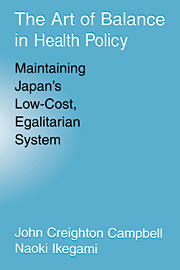Book contents
- Frontmatter
- Contents
- List of Tables and Figures
- Preface
- 1 Low Health-Care Spending in Japan
- 2 Actors, Arenas, and Agendas in Health Policy Making
- 3 Health-Care Providers
- 4 The Egalitarian Health Insurance System
- 5 The Macropolicy of Cost Containment
- 6 The Micropolicy of Cost Containment
- 7 The Quality Problem
- 8 Lessons?
- Index
5 - The Macropolicy of Cost Containment
Published online by Cambridge University Press: 07 October 2011
- Frontmatter
- Contents
- List of Tables and Figures
- Preface
- 1 Low Health-Care Spending in Japan
- 2 Actors, Arenas, and Agendas in Health Policy Making
- 3 Health-Care Providers
- 4 The Egalitarian Health Insurance System
- 5 The Macropolicy of Cost Containment
- 6 The Micropolicy of Cost Containment
- 7 The Quality Problem
- 8 Lessons?
- Index
Summary
DURING the 1970s, Japanese health-care costs exploded, but since the early 1980s, they have been contained within the growth rate of the overall economy. The next two chapters explain how this success was achieved. The story must be told at two levels. In Chapter 6, we take a “micro” approach to see how costs can be controlled, even in a fee-for-service system, by affecting the behavior of individual providers through constraints and incentives built into the fee-schedule and claims-review systems. In the present chapter, however, we focus on “macro” decisions about overall health-care expenditures – the equivalent of what is often called “global budgeting.” Japan's way to make such decisions is a unique hybrid of the approaches found in “single-payer” and “all-payer” systems that we call the “bellwether” approach.
The fact that Japan does use something like a “global budget” has often been missed. For example, the U.S. General Accounting Office concluded in a 1991 report on spending controls in France, Germany, and Japan that limitations on overall health-care budgets, in conjunction with price controls, were more effective than price controls alone in moderating spending growth in France and Germany. The report claimed that Japan does not impose enforceable budget limitations but relies simply on price controls through the fee schedule and broad policy pronouncements about keeping total spending down by the Cabinet or the Economic Planning Agency – presumably carried out through “consensus” since there is no enforcement mechanism.
- Type
- Chapter
- Information
- The Art of Balance in Health PolicyMaintaining Japan's Low-Cost, Egalitarian System, pp. 116 - 144Publisher: Cambridge University PressPrint publication year: 1998

